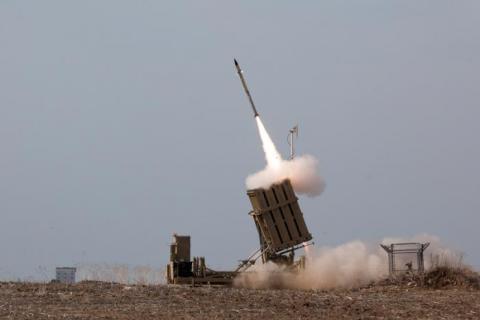With the latest rounds of rocket fire from Hamas fighters in the Gaza strip, Israel's missile defense system, known as Iron Dome, is getting a lot of press again, much of it positive. As with much reporting on missile defense, however, the Iron Dome coverage has lacked context and misconstrued reality.
A CNN article, for example, carried the headline "How Iron Dome blocks rockets from Gaza, protects Israelis" and described a system that had knocked down 56 rockets fired out of Gaza at a string of Israeli cities. The article suggests that the system is accurate and used "only against rockets headed toward populated areas." It does not suggest that there is any question about the system's effectiveness.
The New York Times, noted for its authoritative reporting, wrote that the Israeli Army contended Iron Dome "intercepted about 27 percent of all the rockets fired between Monday night and midday Wednesday." But the Times did not indicate how many missiles had been targeted, leaving the efficiency of the Iron Dome system in this conflict unclear, even as the newspaper reported that "Israel has said that the system has a success rate of nearly 90 percent in intercepting the missiles it is meant to thwart." The Times also put a headline over its online story—"A Growing Arsenal of Homegrown Rockets Encounters Israel’s Iron Dome"—that could be read as suggesting Israel's missile defense was, overall, as effective as its name implies.
And less rigorous news outlets were, of course, less rigorous in their analysis. The New York Post, for instance, reported that "Israel foiled Hamas terrorist attacks from the air and sea."
Ted Postol, an MIT-based missile defense expert and frequent Bulletin contributor, provided a dose of context to the Iron Dome coverage in a National Public Radio interview Wednesday. "We can tell, for sure, from video images and even photographs that the Iron Dome system is not working very well at all," Postol said. "It—my guess is maybe [it hits a targeted missile] 5 percent of the time—could be even lower. ... And when you look—what you can do in the daytime—you can see the smoky contrail of each Iron Dome interceptor, and you can see the Iron Domes trying to intercept the artillery rockets side on and from behind. In those geometries, the Iron Dome has no chance, for all practical purposes, of destroying the artillery rocket."
Regular readers of the Bulletin are well aware of the long history of inflated claims of missile defense efficiency.
Late in 2012, MIT researcher Subrata Ghoshroy brought some reality to hyperbolic claims about Iron Dome's performance in an earlier Israel-Hamas clash: "Israel seems to have shared little information to date, and so there is no way for observers outside the Israeli defense forces to know how successful Iron Dome actually was."
More important, perhaps, Ghoshroy noted that appraisals of Iron Dome should not be misinterpreted as vindication of defense systems that aim to protect against sophisticated, long-range missiles of the type designed to carry nuclear weapons. His analysis is worth quoting at length: "First, let's debunk the myth that Iron Dome—even if as successful as advertised in the Gaza conflict—constitutes proof that missile defense, writ large, works. Terminology is important here. Iron Dome is primarily a rocket defense system, and rockets are fundamentally different from missiles. Rockets do not have a guidance system; missiles do. Rockets follow a trajectory that is determined by the position and angle of the launcher and the propellant. ... While destroying a rocket in this way is a great technical feat, it is not the `hit to kill' system on which the US missile defense effort has been premised, and the Iron Dome system is not intended to work against larger ballistic missiles."
(Many, many Bulletin articles--including a remarkable knockdown, written by Postol and Cornell University researcher George N. Lewis, of a 2012 National Academies missile defense assessment—have chronicled the long, abysmal record and extraordinary cost of the United States' efforts to create a system that could shoot down intercontinental ballistic missiles in mid-flight. Among other things, those articles have noted over time an enduring reality: Simple, cheap decoys and other countermeasures will likely be able to fool the tracking systems for the mid-flight missile defense platforms the United States has largely focused on developing.)
So if Iron Dome says little about the state of true missile defense, and if its effectiveness against short-range rockets is at best unclear and likely overstated, why does the system seem to take center stage whenever Hamas and Israel clash? The answer to that question seems to lie in the public relations arena.
As Postol noted in his public radio interview, Hamas rocket attacks are part of an "intended game." Hamas fires its relatively small, generally inaccurate, and largely ineffective rockets into Israel from Gaza, knowing from past experience that Israel's response will likely involve air strikes that will, despite the accuracy of Israel's high-tech weaponry, kill innocent civilians and, Hamas hopes, make Israel seem a callous oppressor in the eyes of the world.
Meanwhile, the Israeli government presents Iron Dome's performance as part of a sophisticated public relations effort that aims to persuade the broader public that Hamas is a heartless and calculating terrorist organization and Israel's defense forces are decent, determined, and effective. It's an effort that includes, for example, idfnadesk, the YouTube page for the Israel Defense Forces, which offers a video titled "Iron Dome Intercepts Rockets Over Ashdod," among many videos highlighting purported Hamas cruelty and Israeli "pinpoint" and "precision" weapons. To the extent it fills news cycles with reports on Hamas rocket attacks and Iron Dome's supposed technologically advanced method of intercepting them, this PR effort also deflects attention from the human consequences of Israeli bombing strikes in Gaza.
Iron Dome is high-tech. So is the public relations campaign around it, a reality that more of the world news ecosystem could beneficially take note of.


Spread the word